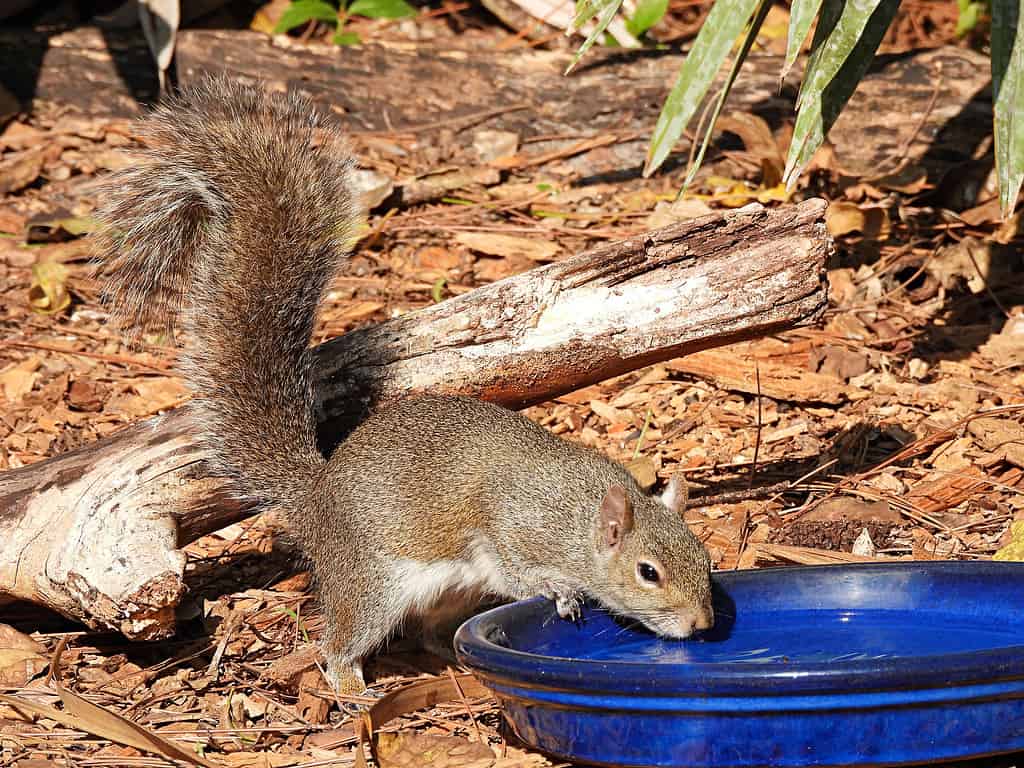
The post Surprising Differences Between Chipmunks and Squirrels appeared first on A-Z Animals.
Chipmunks and squirrels are both widespread throughout North America. While someone with a keen eye can usually tell them apart, their similarities often confuse wildlife watchers. Both rodents are especially active in the fall as they prepare for winter, making this the perfect time to learn how to identify each species with confidence.
Location: Where Are Chipmunks and Squirrels Found?
Squirrels are one of the most commonly found rodents in many residential and rural areas. They’re native to every state except for Hawaii. Chipmunks are also relatively common, but are not native to Hawaii, and only one species is native to Alaska. Native location is the first significant difference between the two.
Types of Squirrels and Where They Live
North America is home to three main types: tree, ground, and flying squirrels. Each type can be further broken down into its species:
- Tree Squirrels: Eastern grey squirrel, fox squirrel, American red squirrel, western gray squirrel, Douglas squirrel, Abert’s squirrel
- Ground Squirrels: California ground squirrel, thirteen-lined ground squirrel, rock squirrel, golden-mantled ground squirrel
- Flying Squirrels: Southern and northern flying squirrels

Squirrels are known for easily adapting to different environments.
©passion4nature/iStock via Getty Images
In the U.S., tree squirrels are the most prevalent species. The eastern gray squirrel is the most common, with the eastern fox squirrel also widespread in many areas. Both of these are highly adaptive and can be found in practically any environment. The eastern gray squirrel is particularly fond of scavenging. It can be found in cities rooting through trash cans, and also in residential areas, climbing bird feeders.
Eastern fox squirrels are known for their agility and prefer woodlands over city streets. They can be found skittering up trees or jumping from one bush to another. Their slightly larger size helps their athleticism, allowing them to move quickly through forested land.
Types of Chipmunks and Where They Live
North America is home to 25 chipmunk species, and all but one are native. They can be broken down into two primary groups: the eastern chipmunk and various western species, including the least chipmunk. Eastern chipmunks are the most widespread species in the East, as their name implies. The least chipmunk is found in northern and western regions, and several other species are found primarily in the west. Least chipmunks are slightly smaller in size but are otherwise identical.

Chipmunks sometimes have similar coloring to squirrels.
©Tom Reichner/Shutterstock.com
There is some overlap in the native habitats of squirrels and chipmunks. However, certain squirrel species, such as the eastern gray squirrel, have adapted to become widespread throughout much of the U.S. While there are more squirrel species than chipmunk species in North America, your chances of spotting either depend heavily on your specific location.
Appearance: How Do Squirrels and Chipmunks Differ?
The most apparent difference between squirrels and chipmunks is their size. Depending on the season, both species can have similar coloring. Therefore, size is usually the best indicator for distinguishing between them. Here’s how the two most predominant U.S. species look in comparison.
Eastern Gray Squirrels and Eastern Fox Squirrels
If you have a lot of squirrel activity in your backyard and live in the eastern or midwestern U.S., it’s most likely due to eastern gray squirrels. These squirrels are the most recognizable, with gray-ish brown fur, a white underbelly, and red or rust-colored fur along their heads and backs. Their fluffy tails are a mixture of gray, white, and red fur, and are one of their most iconic features. These squirrels use their tails for balance and jumping, which comes in handy for this 1-1.5-pound animal. They measure between 18 and 20 inches long, including their tail, making them larger than chipmunks.
Eastern fox squirrels are very similar in appearance to the eastern gray squirrel. The only noticeable difference is their size. They can grow between 19 and 29 inches long, including their tails. Their coloring differs depending on the region and season, but is primarily gray, reddish-brown, and white.
Eastern Chipmunks and Least Chipmunks
The eastern chipmunk is easily recognized due to its mouse-like appearance. However, it’s larger than the average house mouse, measuring 8 to 10 inches long. The maximum weight of most chipmunks is around five ounces, making them a fraction of the size of the eastern fox squirrel. Eastern chipmunks are reddish-brown with black stripes that run down the length of their backs. Cream or white stripes run in between these, matching a white underbelly.
Similar to both squirrel species, least chipmunks are nearly identical to eastern chipmunks. They differ in size, however, with least chipmunks measuring 7.3 to 8.7 inches long, and weighing between 42 and 53 grams. Overall, squirrels are a much larger species with bushier tails and darker coloring.
Diet: What Do Squirrels and Chipmunks Eat?
Since both are rodents, their diets are quite similar. However, squirrels have a slightly broader range of food sources than chipmunks. Both consume seeds, fruit, and nuts as their primary source of fiber and protein. However, chipmunks may also consume grains, small insects, and small reptiles like frogs or snakes. The diets of both animals depend on their proximity to humans and the availability of food for foraging. Chipmunks are known for storing food in their cheeks, hence their notably chubby faces just before winter.

Chipmunks have large cheeks to store food in.
©Fiona M. Donnelly/Shutterstock.com
Squirrels, due to their size, can consume a bit more than a chipmunk. They are also opportunistic feeders and may even scavenge bird nests for eggs and chicks. They’ve also been known to consume large insects like caterpillars, fungi, leftover food scraps, and tree bark. Rather than storing food in their cheeks, squirrels often bury extra food before winter.
Predators: What Preys on Squirrels and Chipmunks?
For such speedy animals, squirrels and chipmunks have plenty of predators on their tails. Both face threats from birds of prey, including owls, hawks, and eagles. Aside from raptors, wild canines and big cats also prey on these animals. Coyotes, foxes, fishers, and bobcats are known to hunt small rodents such as these.

Deforestation threatens chipmunks and squirrels alike.
©Cheri Alguire/Shutterstock.com
Chipmunks face slightly more threats from predators than squirrels due to their small size. This includes snakes that feed on rodents, raccoons, martens, weasels, and minks. Since rodents can trigger the chase instinct in domestic cats and dogs, they are also known predators of chipmunks. Unfortunately, humans also pose a threat to both squirrels and chipmunks through deforestation and habitat loss.
Behavior: How Similar in Nature Are Squirrels and Chipmunks?
Although both are rodents, squirrels and chipmunks have very different behaviors and temperaments. Squirrels are the spunkier of the two, ready to defend their territory without a second thought. This depends on the species, and some squirrels are more aggressive than others. Squirrels can be chatty, utilizing chirps, clicks, and unique vocalizations to communicate with others. They also communicate by using their tails; different twitches or movements convey anything from mating to defensive posturing. Foot stomping is another common method of communication within the species. Unlike chipmunks, some squirrel species can be very social.

Chipmunks can enter torpor, a hibernation-like state, unlike squirrels.
©Margaret M Stewart/Shutterstock.com
Chipmunks are solitary animals and prefer to forage solo. They live in burrows beneath the ground, which is how they keep themselves hidden at night. While they won’t hesitate to defend their underground homes, they’re not as aggressive as some squirrel species. Chipmunks use vocalizations such as chirps, trills, and whistles to communicate with others or as a defense mechanism. However, their socializing is typically limited to mating season.
One distinct characteristic of chipmunks that squirrels don’t possess is the ability to enter torpor. This is a hibernation-like state where chipmunks slow down their metabolism, breathing, and heart rates to survive the winter. They awaken every few days to eat, but remain relatively underground during the coldest months of the year. In regions such as New England, chipmunks enter torpor during October and don’t re-emerge until late spring. However, climate change may affect the timing of when chipmunks enter or leave torpor.
The post Surprising Differences Between Chipmunks and Squirrels appeared first on A-Z Animals.
August 22, 2025 at 12:02AMLianna Tedesco
.jpeg)
.jpeg)

0 Comments